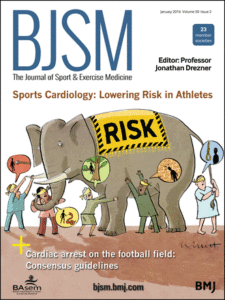…SPORTS CARDIOLOGY: LOWERING RISK IN ATHLETES is the winning cover for 2016! Thank you to everyone that voted. The IOC Exercise & Pregnancy in Athletes Expert Group issue came in a close second.

We caught up with Dr. Jonathan Drezner, Editor of the Sports Cardiology issue, to ask him a few questions.
BJSM: Congratulations! How do you feel about winning “BJSM best cover” for 2016?
This is a great honor! BJSM has a long history of unique and striking covers that draw attention to the important content of each issue. To be selected as the 2016 best cover is an unexpected distinction. But the real credit must be given to the brilliant work of Vicky Earle – BJSM graphics and cover specialist – who behind the scenes makes every cover special and a winner in its own right!
What important message does this cover illustrate?
The January 2016 BJSM issue was a special issue dedicated to sports cardiology and lowering athlete risk towards the prevention of sudden cardiac death (SCD). This topic has captured the interest and efforts of the sports medicine community for many years. Most recently, epidemiologic data has drawn attention to the differential risk of SCD in athletes – i.e. the concept that some athlete groups are at higher risk than others. The cover depicts blindfolded people bumping into an elephant and imaging different risky outcomes. One could interpret many things from this. In the sports cardiology world, many have chosen to keep their head in the sand about athlete risk… unwilling to accept new science and robust data defining high risk groups and continuing to promote misinformation about incidence rates that depict a “rare” problem not worthy of our intervention. We must open our eyes to the problem. The very athletes we are charged of caring for and ensuring their safety on the playing field continue to die. As a medical community, our response has been slow and clouded by debate, misperceptions, and faulty science. For some, we must take off our blindfolds to see the true risk! The solutions are not easy and many potential preventive strategies have their own challenges and limitations, but until we open our eyes as a discipline we cannot move forward.
This cover also carries a personal meaning for me. In October 2015 I was honored to participate in the SASMA conference held in Johannesburg, South Africa. The conference embodied collaboration and mentorship and inspired education at all levels. It also featured a sports cardiology symposium. After the conference the visiting faculty were treated to a safari experience with Dr. Jon Patricios and his family. It was an incredible experience with memories for a life-time. The elephant on the cover is a reminder of my experience in South Africa and also motivated the title and substance of my warm-up for this special issue: “ ‘Big Five’ of sports medicine: preparation, teamwork, passion, mentorship and collaboration. ”
What in this issue, stands out for you as the ‘gold standard’ of SEM work?
This issue had many terrific articles. The original research by Dhutia et al. represents a benchmark study that shed critical understanding on short QTc cut-offs in athletes. It is one of many important contributions by Professor Sanjay Sharma and his research team from St. George’s University of London and the outstanding charity organization CRY (Cardiac Risk in the Young). This study was used to help define QTc threshold values in the new International Criteria for Electrocardiographic Interpretation in Athletes: Consensus Statement (BJSM 2017 May;51(9):704-731).
In your opinion, where do we head from here?
First, Vicky must continue to guide the cover masterpieces of BJSM! From a sports cardiology perspective, we must strive for better prevention, identification of athletes at risk, and safe participation in sports and exercise for all.
***
Stay tuned for the official announcement of the prize winners.